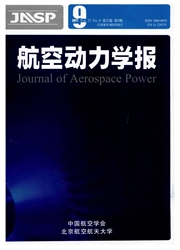

 中文摘要:
中文摘要:
The cold flow characteristics are investigated to show the effect of the structural parameters of the flow guide vane on the trapped vortex combustor(TVC). The results show that the structural parameters have significant effects on the TVC. As a/ H increases, the total pressure loss, the wall shear stress at the bottom of the cavity and the turbulent intensity in the main combustion zone increase. b/ B does not have a significant effect on the cavity flow structure and the total pressure loss, and the wall shear stress at the bottom of the cavity increases as b/ B increases. There is no significant increase of the turbulent intensity with the increase of b/ B. The increase of c/ L has little effect on the total pressure loss, and it is not conducive to a stable combustion. As c/ L increases, the wall shear stress at the bottom of the cavity decreases. When a/ H= 0.4, b/ B= 0.4, c/ L= 0.1, a desirable dual-vortex structure is formed with an acceptable pressure loss to achieve a stable combustion. Moreover, to ascertain that the flame is stable for different values of Vm a with the optimal structural parameters, the effect of Vm a on the flow field is discussed. Results suggest that the dual-vortex structure has no relationship with the increase of Vm a. Furthermore, an unsteady simulation is conducted to show the generation and the development of the dual-vortex.
 英文摘要:
英文摘要:
The cold flow characteristics are investigated to show the effect of the structural parameters of the flow guide vane on the trapped vortex combustor(TVC). The results show that the structural parameters have significant effects on the TVC. As a/ H increases, the total pressure loss, the wall shear stress at the bottom of the cavity and the turbulent intensity in the main combustion zone increase. b/ B does not have a significant effect on the cavity flow structure and the total pressure loss, and the wall shear stress at the bottom of the cavity increases as b/ B increases. There is no significant increase of the turbulent intensity with the increase of b/ B. The increase of c/ L has little effect on the total pressure loss, and it is not conducive to a stable combustion. As c/ L increases, the wall shear stress at the bottom of the cavity decreases. When a/ H= 0.4, b/ B= 0.4, c/ L= 0.1, a desirable dual-vortex structure is formed with an acceptable pressure loss to achieve a stable combustion. Moreover, to ascertain that the flame is stable for different values of Vm a with the optimal structural parameters, the effect of Vm a on the flow field is discussed. Results suggest that the dual-vortex structure has no relationship with the increase of Vm a. Furthermore, an unsteady simulation is conducted to show the generation and the development of the dual-vortex.
 同期刊论文项目
同期刊论文项目
 同项目期刊论文
同项目期刊论文
 期刊信息
期刊信息
